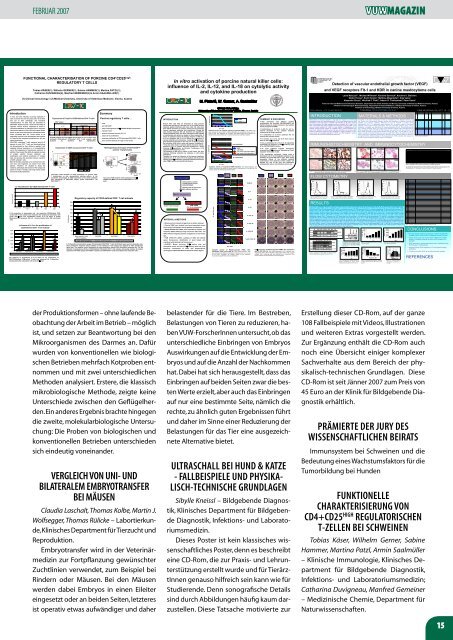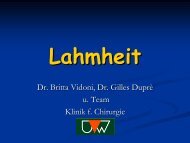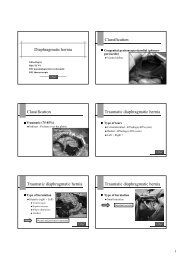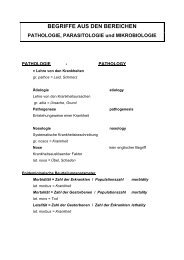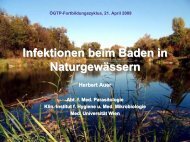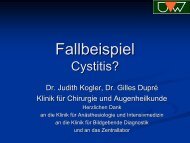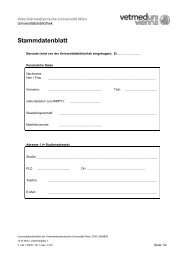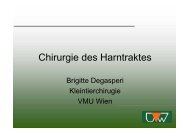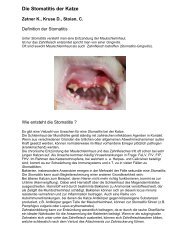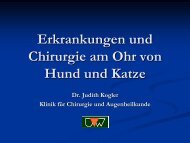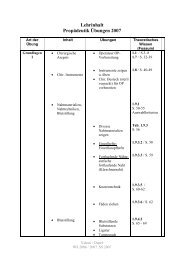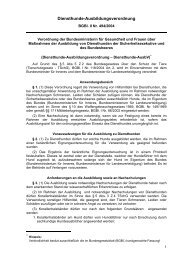WeiSSeS Gold Milch - Veterinärmedizinische Universität Wien
WeiSSeS Gold Milch - Veterinärmedizinische Universität Wien
WeiSSeS Gold Milch - Veterinärmedizinische Universität Wien
Erfolgreiche ePaper selbst erstellen
Machen Sie aus Ihren PDF Publikationen ein blätterbares Flipbook mit unserer einzigartigen Google optimierten e-Paper Software.
Introduction<br />
FUNCTIONAL CHARACTERISATION OF PORCINE CD4 + CD25 high<br />
REGULATORY T CELLS<br />
Tobias KÄSER(1), Wilhelm GERNER(1), Sabine HAMMER(1), Martina PATZL(1),<br />
Catharina DUVIGNEAU(2), Manfred GEMEINER(2) & Armin SAALMÜLLER(1)<br />
(1) Clinical Immunology / (2) Medical Chemistry, University of Veterinary Medicine, Vienna, Austria<br />
In men and mice naturally occurring regulatory T<br />
cells are known for over ten years and a lot of effort<br />
was put in their phenotypic and functional<br />
characterisation. To date, they are described as<br />
CD4 + CD25 + thymus derived T cells with the ability to<br />
suppress various immune responses to ensure a<br />
controlled abatement of pathogens and to suppress<br />
autoimmune effector-T cells. The only explicit marker<br />
known to date is the intra-cellular transcription factor<br />
Foxp3 (Forkhead Box P3). Foxp3 seems to be<br />
essentially involved in the development and function<br />
of Tregs but the complete mechanisms are still not<br />
clearly understood.<br />
CD4 + CD25 + regulatory T cells represent about 5-10<br />
percent of naive CD4 + T cells and functionally they<br />
are characterised by their ability to regulate T-cell<br />
mediated immune responses, i.e. in transplantation<br />
and in the suppression of autoimmune reactions. In<br />
addition, they present the ability to regulate any type<br />
of antigen specific immune response; e.g.<br />
proliferation and cytokine production of T-helper<br />
cells and primary and secondary immune reactions<br />
of CD8 + cytolytic T cells.<br />
Most of the data presented so far, derived from men<br />
and mice only fragments are known from other<br />
species. Therefore, we decided to study the<br />
existence, phenotype and function of this unique cell<br />
subset in swine a broadly used large animal model<br />
for several medical questions.<br />
CD25 -<br />
Foxp3<br />
CD4 + subset<br />
IL-10 production of splenocytes and the respective CD25-defined FCMsorted<br />
CD4 + T-cell subsets was measured after polyclonal stimulation with<br />
ConA (2.5 μg/ml) and recombinant human IL-2 (10 IU/ml) in ELISA<br />
(Biosource). SI represents OD IL-2 + ConA activated cells/ OD unactivated<br />
cells.<br />
cpm<br />
Stimulation Index (SI)<br />
30000<br />
25000<br />
20000<br />
15000<br />
10000<br />
5000<br />
IL-10 production by CD25-defined CD4 + T-cells<br />
splenocytes splenocytes<br />
+ab<br />
februar 2007<br />
CD4<br />
CD25<br />
CD4<br />
CD25<br />
Influence of IL-2 on the proliferation of<br />
CD25-defined CD4 + T-cell subsets<br />
Expression of Foxp3 in CD25-defined CD4 + T-cells<br />
ex vivo<br />
dim<br />
in vitro cultivated<br />
medium IL-2+ConA medium IL-2+ConA<br />
… have a heterogeneous CD8α, CD45RC & MHC-II expression<br />
high - - +<br />
+<br />
… express Foxp3<br />
… produce increased amounts of IL-10<br />
… need IL-2 for proliferation<br />
… suppress proliferation of CD3-stimulated CD4 + CD25 - T cells<br />
… show common features of Tregs in mice & men<br />
RT-PCR-products of Foxp3 mRNA derived from ex vivo or 16h in vitro<br />
cultivated CD25-defined FCM-sorted CD4 + T-cell subsets were<br />
analysed by Southern Blot hybridisation.<br />
Expression of CD25 on porcine CD4 + T-cells<br />
a b<br />
CD25<br />
Two-colour FCM analyses of CD25 expression on porcine CD4 +<br />
T lymphocytes; a) one representative staining pattern, b) the<br />
cumulative percentages of CD25 expression of 22 swine analysed;<br />
grey percentage of CD4 + CD25 - subset, yellow CD4 + CD25 dim , red<br />
CD4 + CD25 high .<br />
CD4<br />
CD25<br />
0<br />
splenocytes splenocytes +ab CD4+CD25dim CD4+CD25high<br />
bright: MW Medium med bright: MW IL-2 med dark: MW ConA dark: MW IL-2+ConA<br />
The influence of recombinant IL-2 (10 IU/ml) on the proliferation of<br />
CD4 + CD25-defined FCM-sorted T cells was measured by 3 H-thymidine<br />
incorporation after stimulation with ConA (2.5 μg/ml).<br />
ConA without IL-2<br />
ConA without IL-2<br />
CD4<br />
CD25<br />
CD4<br />
CD25<br />
CD4<br />
CD25<br />
CD4<br />
% Proliferation<br />
180<br />
160<br />
140<br />
120<br />
100<br />
80<br />
60<br />
40<br />
20<br />
0<br />
negative dim high<br />
Mean controls (+/-CD3)<br />
without regulators<br />
Summary<br />
Porcine regulatory T cells…<br />
… exist<br />
… are CD4 + CD25 +<br />
der Produktionsformen – ohne laufende Beobachtung<br />
der Arbeit im Betrieb – möglich<br />
ist, und setzen zur Beantwortung bei den<br />
Mikroorganismen des Darmes an. Dafür<br />
wurden von konventionellen wie biologischen<br />
Betrieben mehrfach Kotproben entnommen<br />
und mit zwei unterschiedlichen<br />
Methoden analysiert. Erstere, die klassisch<br />
mikrobiologische Methode, zeigte keine<br />
Unterschiede zwischen den Geflügelherden.<br />
Ein anderes Ergebnis brachte hingegen<br />
die zweite, molekularbiologische Untersuchung:<br />
Die Proben von biologischen und<br />
konventionellen Betrieben unterschieden<br />
sich eindeutig voneinander.<br />
VerGleich Von Uni- UnD<br />
bilateralem embryotransfer<br />
bei mäUsen<br />
Claudia Laschalt, Thomas Kolbe, Martin J.<br />
Wolfsegger, Thomas Rülicke – Labortierkunde,<br />
Klinisches Department für Tierzucht und<br />
Reproduktion.<br />
Embryotransfer wird in der Veterinärmedizin<br />
zur Fortpflanzung gewünschter<br />
Zuchtlinien verwendet, zum Beispiel bei<br />
Rindern oder Mäusen. Bei den Mäusen<br />
werden dabei Embryos in einen Eileiter<br />
eingesetzt oder an beiden Seiten, letzteres<br />
ist operativ etwas aufwändiger und daher<br />
CD25<br />
Heterogeneous phenotype of CD4 + CD25 high<br />
porcine T lymphocytes<br />
CD4<br />
CD25<br />
CD4<br />
CD8α<br />
MHC-II<br />
CD45RC<br />
CD45RC<br />
Four-colour FCM analysis of the expression of CD8α,<br />
CD45RC and MHC-II on porcine CD4 + CD25 high T cells<br />
(red).<br />
Regulatory capacity of CD25-defined CD4 + T-cell subsets<br />
CD4 + CD25 - CD4+ CD25 dim CD4+ CD25 high<br />
dark: 2x10 5 regulators medium: 1x10 5 regulators bright: 5x10 4 regulators<br />
In 3 H-thymidine incorporation assays CD3-stimulated CD4 + CD25 - T cells (2x10 5 /well) were used as responder cells.<br />
Their proliferative response without addition of any additional T-cell subsets was adjusted to 100% proliferation<br />
(black bar). The negative control represents the same population without CD3 stimulation (scattered bar). For the<br />
detection of suppressive effects of CD25-defined FCM-sorted CD4 + T-cell subsets, decreasing numbers of putative<br />
regulators CD4 + CD25 - (grey), CD4 + CD25 dim (yellow) and CD4 + CD25 high (red) were added to the responder cells.<br />
In vitro activation of porcine natural killer cells:<br />
influence of IL-2, IL-12, and IL-18 on cytolytic activity<br />
and cytokine production<br />
INTRODUCTION<br />
Natural killer cells (NK) are described as large granular<br />
lymphocytes that play an important role in the innate immune<br />
response against infections and tumor cells. NK cells exert<br />
their effector functions by cytolytic activity and by producing<br />
immune regulatory cytokines and chemokines. During the<br />
early immune response, NK cell functions are regulated by<br />
cytokine feedback loops and direct interactions with infected<br />
or transformed cells which are targets of their cytotoxicity. A<br />
series of cytokines control the biologic behavior of NK cells.<br />
IL-2 can synergize with IL-12 to induce the production of<br />
various cytokines and chemokines, including IFN-γ. Recently,<br />
great interest has focused on the role of IL-12 and/or IL-18 on<br />
the activation of NK cells in mice and humans. In addition IL-<br />
12 has also been shown to possess potent anti-tumor activity,<br />
whereas IL-18 is a cytokine that was identified as a factor<br />
inducing IFN-γ production by NK-cells. Furthermore, IL-18<br />
augments NK-cell activity in vitro.<br />
The existence of NK cells in swine is well known, but their<br />
response following activation by cytokines is still poorly<br />
understood.<br />
Therefore, we tested the influence of the immune regulatory<br />
cytokines IL-2, IL-12, and IL-18 on the cytolytic activity and the<br />
capacity for IFN-γ production of peripheral blood mononuclear<br />
cells (PBMC) and an enriched NK-cell fraction.<br />
Porcine PBMC<br />
staining with a cocktail<br />
of mAb against porcine<br />
CD3/CD21/SWC3<br />
labelling with rat anti-mouse<br />
IgG1 magnetic particles<br />
MACS separation<br />
CD3 + CD21 + CD21 SWC3 + SWC3 CD3 -- CD21 --SWC3 SWC3 --<br />
B cells/ T cells/ monocytes<br />
NK cells<br />
CD21- B-cell subpopulation<br />
positive fraction negative fraction<br />
MATERIAL & METHODS<br />
� Blood was from 6-month-old pigs from an abattoir obtained.<br />
� Porcine PBMC were isolated from fresh heparinized venous<br />
blood using Ficoll-Hypaque density gradient centrifugation.<br />
� MACS-SEPARATION: PBMC were separated by magnetic cell<br />
separation (MACS, Miltenyi) using anti-porcine CD3, CD21, and<br />
SWC3 mAb and magnetic particles conjugated to rat anti-mouse<br />
IgG 1 .<br />
� FCM CYTOLYTIC ASSAY: Labelling of K562 with DIOC18<br />
(green fluorescence), identification of lysed targets with<br />
propidium iodide staining (red fluorescence).<br />
� ELISPOT: Mouse anti-swine IFN-γ capture mAb and<br />
biotinylated mouse anti-swine IFN-γ detecting mAb both from<br />
Biosource. Visualisation of spots with Streptavidin-AP<br />
(Invitrogen) and BCIP/NBT Buffered Substrate tablets (Sigma).<br />
�������������������������������������<br />
���������������������<br />
���������������������������������������������������������<br />
% specific lysis<br />
E:T ratio<br />
Influence of IL-2 on cytolytic activity of porcine PBMC. 1x10 6 PBMC/ well<br />
were cultivated in medium with or without stimulation with recombinant human IL-2 (10<br />
IU/ml) for 48h. After additional 18h incubation with labelled K562 cells as targets, the<br />
cytolytic activity was quantified as % of specific lysis by flow cytometric analyses.<br />
% specific lysis<br />
SUMMARY & DISCUSSION<br />
� After stimulation with different cytokine<br />
combinations, the enriched CD3-CD21-SWC3 - cell<br />
fraction showed an evident increase in the cytolytic<br />
activity compared to PBMC.<br />
�The experiments performed, clearly show a<br />
stimulatory role of the investigated cytokines in the<br />
IL-2 stimulated<br />
activation of porcine NK cells in vitro. Also, strong<br />
synergistic effects of the different cytokine<br />
combinations were observed. Further studies will<br />
address the role of NK cells and lymphokine<br />
E:T ratio<br />
activated killer cells in viral infections and in vivo.<br />
Cytolytic activity of separated PBMC-fractions. After MACS-separation, cell<br />
fractions were either used directly in cytolytic assays or cultivated with IL-2 for 48 hours. The<br />
cytolytic activity was detected as described above.<br />
% specific lysis<br />
PBMC<br />
mAb- mAb<br />
PBMC<br />
E:T ratio<br />
PBMC<br />
PBMC + IL-2<br />
non-stimulated<br />
PBMC<br />
mAb-PBMC<br />
pos. fraction (CD3 + CD21 + SWC3 + )<br />
neg. fraction (CD3 - CD21 - SWC3 - )<br />
pos. neg.. neg<br />
PBMC<br />
mAb- mAb<br />
PBMC<br />
belastender für die Tiere. Im Bestreben,<br />
Belastungen von Tieren zu reduzieren, haben<br />
VUW-ForscherInnen untersucht, ob das<br />
unterschiedliche Einbringen von Embryos<br />
Auswirkungen auf die Entwicklung der Embryos<br />
und auf die Anzahl der Nachkommen<br />
hat. Dabei hat sich herausgestellt, dass das<br />
Einbringen auf beiden Seiten zwar die besten<br />
Werte erzielt, aber auch das Einbringen<br />
auf nur eine bestimmte Seite, nämlich die<br />
rechte, zu ähnlich guten Ergebnissen führt<br />
und daher im Sinne einer Reduzierung der<br />
Belastungen für das Tier eine ausgezeichnete<br />
Alternative bietet.<br />
Ultraschall bei hUnD & katze<br />
- fallbeispiele UnD physikalisch-technische<br />
GrUnDlaGen<br />
Sibylle Kneissl – Bildgebende Diagnostik,<br />
Klinisches Department für Bildgebende<br />
Diagnostik, Infektions- und Laboratoriumsmedizin.<br />
Dieses Poster ist kein klassisches wissenschaftliches<br />
Poster, denn es beschreibt<br />
eine CD-Rom, die zur Praxis- und Lehrunterstützung<br />
erstellt wurde und für TierärztInnen<br />
genauso hilfreich sein kann wie für<br />
Studierende. Denn sonografische Details<br />
sind durch Abbildungen häufig kaum darzustellen.<br />
Diese Tatsache motivierte zur<br />
medium<br />
IL-2<br />
IL-12<br />
IL-18<br />
IL-2/IL-12<br />
IL-2/IL-18<br />
IL-12/IL-18<br />
IL-2/IL-12/IL-18<br />
Cytolytic activity of MACS-separated PBMC after<br />
stimulation with IL-2/IL-12/IL-18. After MACS-separation, cells<br />
were cultivated with different combinations of cytokines (IL-2, IL-12, IL-18)<br />
for 48 hours. Thereafter, the cytolytic activity of the respective<br />
microcultures against K562 cells was determined.<br />
� Combinations of IL-2/IL-12, IL-2/IL-18, and IL-<br />
12/IL-18 increased of the cytolytic response<br />
compared to the single cytokines.<br />
� A combination of all three cytokines did not<br />
enhance this cytolytic activity.<br />
� In contrast, IL-2, IL-12, and IL-18 alone had no<br />
effect on the IFN-γ production.<br />
� Only a combination of IL-12 and IL-18 augmented<br />
significantly the frequency of IFN-γ producing cells<br />
in the CD3-CD21 -SWC3- fraction.<br />
� All three cytokines together dramatically<br />
increased the IFN-γ production, indicating an "overresponse"<br />
of the cells in vitro.<br />
pos. neg.<br />
IFN-γ production of MACS-separated PBMC after stimulation<br />
with IL-2/IL-12/IL-18. After MACS-separation, 5x10 4 cells/well were<br />
incubated for 38h in 96-well ELISPOT plates coated with an IFN-γ capture<br />
antibody. IFN-γ producing cells were detected by a biotinylated IFN-γ<br />
specific antibody and the respective enzyme-conjugates.<br />
Detection of vascular endothelial growth factor (VEGF)<br />
and VEGF receptors Flt-1 and KDR in canine mastocytoma cells<br />
Laura Rebuzzi ‡ *, Michael Willmann ‡ , Karoline Sonneck*, Karoline V. Gleixner*,<br />
Stefan Florian*, Rudin Kondo*, Matthias Mayerhofer*, Anja Vales*,<br />
Alexander Gruze # , Winfried F. Pickl # , Johann G. Thalhammer ‡ , Peter Valent*<br />
‡ Clinic for Internal Medicine and Infectious Diseases, Department for Small Animals and Horses, University of Veterinary Medicine Vienna, Austria;<br />
*Division of Hematology & Hemostaseology, Department of Internal Medicine I, Medical University of Vienna, Austria;<br />
# Institute of Immunology, Medical University of Vienna, Austria.<br />
2006 ANNUAL VCS CONFERENCE E-mail address: michael.willmann@vu-wien.ac.at<br />
PINE MOUNTAIN, GA, OCT. 19 – 22<br />
INTRODUCTION<br />
FLOW CYTOMETRY<br />
Figure3: Expression of Flt-1 on C2 Figure4: No expression of KDR is detectable Figure5: Expression of CD9 on C2 cells<br />
cells determined by flow cytometry. on the surface of C2 cells by flow cytometry<br />
determined by flow cytometry.<br />
Figure 7: Expression of VEGF mRNA and VEGF-R mRNA<br />
in canine mastocytoma cells determined by RT-PCR<br />
MATERIALS & METHODS<br />
Mastocytomasare frequent neoplasmsin dogs with poor response to conventional We worked on the canine mastocytoma cell line C2 (established by Prof. Rebekah DeVinney and<br />
antineoplasticdrugs and unfavorable prognosis. Thus, current attempts focus on the Prof. Warren <strong>Gold</strong>, Cardiovascular Research Institute and Department of Medicine, University of<br />
identification of new drug targets in neoplasticmast cells (MC). So far, little is known California, San Francisco, California, Reference #1) and we analyzed 18 primary canine<br />
about the phenotype and target expression profile of neoplastic MC in dogs. The mastocytomas (Tab.1). To characterize canine neoplastic MC, we used a number of monoclonal<br />
aims of the present study were to establish the phenotype and target profile of C2 antibodies (mAb) against defined CD-antigens and mast cell-related antigens (Tab.2, Tab.3).<br />
cells and primary neoplasticMC. VEGF is a major regulator of angiogenesis and a Expression of antigens was determined by Immunocytochemistry (Fig.2), Immunohistochemistry<br />
potential autocrine growth regulator for neoplastic cells in various leukemias and (Fig.1) and flow cytometry (Fig.3, Fig.4, Fig.5, Fig.6). Detection of VEGF protein was determined by<br />
solid tumors. Recently, the canine system has been described to be a most useful ELISA (Quantikine, R&D,). RT-PCR [RT-PCR reactions were performed with the Protoscript First<br />
model for studying the biology and gene expression in various neoplasms. In the Strand cDNA Synthesis kit (New England Biolabs, Beverly, MA) using 1 µg total RNA in a 50 µL<br />
present study, we investigated expression of VEGF and VEGF-receptors in canine reaction volume] and Northern Blotting were used to detect VEGF mRNA. We performed functional<br />
mastocytomas and the canine mastocytoma cell line C2.<br />
assays, such as the ³H-thymidine uptake assay to determine growth-modulating effects of rapamycin<br />
and applied Northern blotting technique for the measurement of VEGF-production after exposure of Table 1: patients’ characteristics<br />
the cells to certain inhibitors (LY294002, rapamycin, PD98059).<br />
IMMUNOHISTOCHEMISTRY AND IMMUNOCYTOCHEMISTRY<br />
KIT KIT KIT<br />
VEGF VEGF VEGF<br />
Figure 1: Photomicrograph of serial section staining of primary canine mastocytoma<br />
cells with the specific antibodies against CD117 (KIT) and VEGF<br />
Figure 6: Expression of CD117 (KIT) on<br />
C2 cells determined by flow cytometry.<br />
Figure 8: VEGF mRNA expression in C2 cells<br />
is counteracted by the PI3-kinase inhibitor Figure 9: time-dependent presence of VEGF Figure 10: time-dependent presence of VEGF<br />
LY294002 and the mTor-inhibitor rapamycin, in C2 cell lysates<br />
in C2 cell-free supernatants<br />
but not by the MEK-inhibitor PD98059<br />
(Northern blot)<br />
Fig.11: time-dependent increase of VEGF in<br />
cell-free supernatants of primary canine<br />
mastocytoma cells (patient #16 in Table 1)<br />
KIT Tryptase Flt-1<br />
VEGF VEGF+BP KDR<br />
Figure 2: Photomicrograph of cultured C2 cells stained with specific antibodies against CD117<br />
(KIT), tryptase, VEGF, VEGF+ blocking peptide, VEGFR-1 (Flt-1) and VEGFR-2 (KDR)<br />
RESULTS<br />
In our study we investigated expression of VEGF and VEGF-receptors in canine mastocytomas and the canine mastocytoma cell line C2. As assessed by immunostaining of tissue<br />
sections and cytospin-slides, primary neoplastic MC as well as C2 cells were found to express the VEGF protein. In Northern blot experiments, C2 cells expressed VEGF mRNA.<br />
(Fig.8) Primary MC and C2 cells expressed VEGF mRNA in a constitutive manner in RT-PCR experiments, (Fig.7) In consecutive experiments, C2 cells were found to express VEGF<br />
receptor-1 (Flt-1) and VEGF receptor-2 (KDR) at the mRNA level (Fig.7). By contrast, primary canine mastocytoma cells expressed KDR but did not express Flt-1 in our RTexperiments<br />
(Fig.7) However, primary cells as well as C2 cells expressed both Flt-1 protein and KDR protein, detectable by ICC (Tab.2, Fig. 2) We were also interested to know<br />
whether neoplastic canine MC express VEGF receptors on their surface. As assessed by flow cytometry, C2 cells were found to express Flt-1 on their surface (Tab.3, Fig.3).By<br />
contrast, we were not able to detect KDR on the surface of C2 cells (Tab.3, Fig.4). In control experiments, C2 cells were found to co-express a number of other leukocyte<br />
differentiation antigens (Tab.3). Furthermore, the VEGF protein was found to accumulate in cell lysates and cell-free supernatants of C2 cells and in cell lysates of primary canine<br />
neoplastic MC over time indicating constant production and secretion of the ligand (Fig.9, Fig.10, Fig.11). VEGF mRNA expression in C2 cells was counteracted by LY294002 and<br />
rapamycin suggesting involvement of the PI3-kinase/mTOR pathway, whereas little if any effects were seen with the MEK inhibitor PD98059 (Fig.8). In consecutive experiments, we<br />
found that rapamycin decreases the levels of the VEGF protein in C2 cell cultures in a time- and dose-dependent manner (Fig.12). These data suggest that the PI3-kinase/Akt/mTORpathway<br />
contributes to the production and expression of VEGF in neoplastic canine MC. In a next step, we asked whether the rapamycin-induced depletion of VEGF is associated<br />
with growth inhibition. However, in these experiments, rapamycin failed to downregulate growth of C2 cells over the dose-range tested (1 nM – 10 µM; Fig.13) In summary, our data<br />
show that dog mastocytoma cells express VEGF receptors as well as VEGF in a constitutive manner. However, despite receptor expression and constant secretion of VEGF, this<br />
cytokine apparently is not a major (autocrine) growth regulator in dog mastocytomas.<br />
Figure 12: dose-dependent effect of rapamycin<br />
on VEGF expression of C2 cells at day 10 (cell<br />
lysates)<br />
Figure 13: rapamycin fails to<br />
downregulate proliferation of<br />
C2 cells<br />
REFERENCES<br />
Erstellung dieser CD-Rom, auf der ganze<br />
108 Fallbeispiele mit Videos, Illustrationen<br />
und weiteren Extras vorgestellt werden.<br />
Zur Ergänzung enthält die CD-Rom auch<br />
noch eine Übersicht einiger komplexer<br />
Sachverhalte aus dem Bereich der physikalisch-technischen<br />
Grundlagen. Diese<br />
CD-Rom ist seit Jänner 2007 zum Preis von<br />
45 Euro an der Klinik für Bildgebende Diagnostik<br />
erhältlich.<br />
prämierte Der JUry Des<br />
Wissenschaftlichen beirats<br />
Table 2: antibodies used in immunocytochemistry staining experiments<br />
Table 3: Detection of leukocyte antigens in canine mastocytoma cells<br />
Immunsystem bei Schweinen und die<br />
Bedeutung eines Wachstumsfaktors für die<br />
Tumorbildung bei Hunden<br />
fUnktionelle<br />
charakterisierUnG Von<br />
cD4+cD25 hiGh reGUlatorischen<br />
t-zellen bei schWeinen<br />
Tobias Käser, Wilhelm Gerner, Sabine<br />
Hammer, Martina Patzl, Armin Saalmüller<br />
– Klinische Immunologie, Klinisches Department<br />
für Bildgebende Diagnostik,<br />
Infektions- und Laboratoriumsmedizin;<br />
Catharina Duvigneau, Manfred Gemeiner<br />
– Medizinische Chemie, Department für<br />
Naturwissenschaften.<br />
Immunocytochemical detection of leukocyte antigens in neoplastic mast cells<br />
primary neoplastic canine mast cells* phenotype of neoplastic human mast cells<br />
Marker/Antigen C2 cells #9 #12 #15 #16<br />
n.d., not determined; *the numbers refer to the patients depicted in Table 1; locations of tumor sites were: #9, skin,<br />
right chest; #12, skin, left base of the neck; #15, skin, left dorsal carpal region; #16, skin, ventral chest; *score: +++, all<br />
cells strongly reactive; ++, all cells positive; +, ������������s reactive; +/-,


